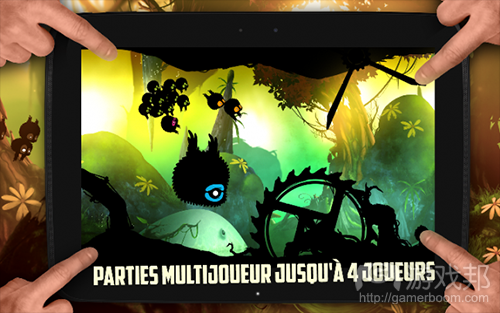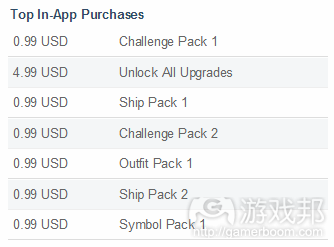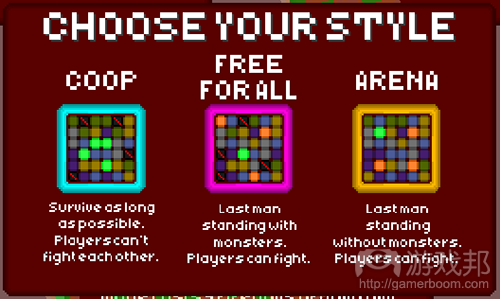平板电脑游戏本地多人模式设计建议及禁忌
作者:Baptiste Villain
也许因为我是家中的独子,所以一直对本地多人游戏情有独钟。我的游戏生涯始于NES和SNES时代,后来就是街机和桌面游戏……但我现在却无法在平板电脑和手机上找到曾一度令我兴奋的本地多人游戏。
当然,有些此类游戏的确很棒,例如《Badland》,或者像《Spaceteam》这种独特的体验。但能够达到这种质量水准的游戏真是太少了!
那么为什么平板电脑上没有多少本地多人游戏,而主机上却有大量此类出色游戏呢?我认为这是因为移动平台上的本地多人游戏并不是一个有利可图的市场。没有多少玩家愿意在移动设备上玩此为游戏,更没有人愿意为之掏钱。
虽然这听起来想是个悲观的论调,但如果你还是想创造一款本地多人手机游戏,不妨借鉴本文所列出的一些建议和禁忌。我要先从禁忌入手,其中的支持数据来自我的最新游戏《Swoc: of Swords and Blocks》(含独立和多人模式的连线消除游戏),此外还有来自App Annie的市场分析数据,以及我所喜爱的一些游戏例子。
禁忌
不要指望从多人模式中创收
我认为你必须正视以下现实:
*根据我的游戏《Swoc》数据所显示,与单人模式相比,只有不到5%的玩家会体验本地多人模式。创造一款可盈利的游戏原本就很困难了,如果你还试图通过这5%的潜在销量创收,那你必定是死路一条。
*据App Annie数据显示,《Spaceteam》(在我看来,它算是最成功的典型之一)收益也很不理想。它仅有3天时间位居美国畅销榜单前1500名,现在排名已经下跌了。粗略统计,我认为这款游戏每月iOS收益最多只有3000美元。在Android平台每月也许是1000至2000美元收益。对于单人的独立开发者来说,这个数字还过得去,但要记住,他可是我们当中的例外。
*你可能会问:“那么《Badland》情况怎样?它是很成功的游戏”《Badland》的卖点并不在于多人模式。你有没有看到它在其官方预告视频或截图中提到这个模式?有,但只有一次!并且仅在Google Play最后一个截图中出现!《Badland》是靠画面和单人模式取胜。我甚至还得向一个已经购买了这款游戏的朋友展示它的本地多人模式,因为他根本就没有发现这一点。
不要把盈利搞砸了
这听起来与第1点颇为相似,但它也适用于那些整合了单人和本地多人模式的游戏。要知道只从游戏中赚一点小钱并不意味着你颗粒无收。
本地多人游戏的盈利非常简单:
*如果它只需要1台设备:那就设为付费模式。
*如果它像《Neon Defender》一样需要多台设备……那你的情况就很不妙了,你必须选择免费模式,以便每位玩家都能参与。但这样你就得提供IAP模式了。定制选项很好,但你最好是提供额外内容。再看看来自App Annie关于《Spacteam》最佳IAP的情况:挑战内容包的销量高于船支只,装备和表情,因为它们引进了一些新机制。
*这种情况下免费模式的一个替代方法是引进“客户端服务器”阶级,让玩家为服务器/托管付费,但允许他们免费邀请任意数量的好友加入。
(《SpaceTeam》中最受欢迎的IAP表明内容最受欢迎)
不要因本地多人模式而把单人元游戏搞砸了
在此我所谓的元游戏是指你游戏中单人模式的最大玩法循环。我在自己的游戏中就犯了这个错误。在《Swoc》中,你在同一台设备最多可以和4个人一起玩游戏。所以我一开始需要4个解琐的角色,以便运行多人模式。而单人模式中却只能解琐两个角色(我总共设计了6个角色),而这实际上并不足以为游戏带来良好的重玩价值。我正在开发一项拥有3个新角色的内容更新,它最终应该适用于《Swoc》,但要注意单人内容与多人内容之间的交互。
不要提供冗长的多人模式会话
这一点是显而易见的。你在开发一款手机游戏,不要寄希望于一名单人玩家会连续投入20分钟。也不要寄希望于4个喝酒和聊天的人能够保持超过5分钟以上的注意力!这正是《Fingle》或《Bam Fu》设计的成功之处。
当然,我在《Swoc》中就犯了这个错误,其游戏会话时间在开发游戏的每次迭代中变得越来越长,但我还没有找到一个解决方兴未艾。所以一开始就要注意这个问题,否则你的整个多人模式设计基础都会有问题。
建议
允许不同数量的玩家加入游戏
我告诉过你只有不到5%的《Swoc》玩家体验了多人模式。不至它至少允许2、3、4名玩家以竞争或合作模式一起玩游戏。想象一下,如果我设计这款游戏时只允许4名玩家参与会怎样?这样只会产生更少的多人模式游戏行为。你必须允许2人游戏模式,任何介于2人或你所能允许的最大玩家数量,你也要尝试一下。如果你的核心设计支持这些玩法,那就提供不同的游戏模式,就像《King of Opera》的做法一样。
我们原来就很难集合本地多人玩家了,所以就不要再为这一体验设限了。
(《Swoc》中的多人模式选择)
但还是要注意,许多设备支持超过5个以上的多次点触行为,最新的设备甚至支持10次同时点触。当你看到像《O》这样的游戏时,你就知道这些限制究竟会对可同时允许8人参与的疯狂设计造成多大损害了。
提供一些显而易学的玩法
如果你在开发F2P游戏,你就知道创建教程的难度有多大了。你可能会认为自己的游戏根本不应该有教程。对于本地多人模式来说,这种看法100%正确。
首要原因是人们在开始游戏之前,很难步调一致地查看游戏规则。
第二个原因是多数情况下,你的一些玩家能够比游戏本身更好地解释游戏规则:某个群体中有人购买了你的游戏,所以他必定知道其基本规则,然后就会教其他人玩,为后者释疑解惑和演示玩法,这正是教程所无法做到的。
除了教程,你还要记住自己需要一款拥有大量反馈的好游戏,这样人人都会知道其中的情况。大量反馈还有助于人们一目了然地看出游戏操作方式。
这一点看似显而易见,但我刻自己在《Badland》的头几回游戏中发现,人们不知道自己选择了什么颜色,或者不知道自己应该怎样飞行。即使是《Bam Fu》也需要一两次过程才能够被所有人理解!
我必须承认这方面是《Swoc》的另一个失败之处:它只是一款连线消除游戏……但这里有许多需要理解的细节,对于本地多人模式来说它太复杂了。
在核心玩法中要有良好的随机性
你必须采用大量随机性,因为随机性会创造不公平,而不公平的游戏最适合本地多人模式。你当然不会希望游戏具有可预测性(即赢家总是相同的人),因为这是竞争,它更适用于在线而非本地游戏。Asher Vollmer(《Threes》开发者)最近公布其下个项目《Close Castles》消息,它看起来很有趣,但我认为缺乏任何随机性会产生一些平衡性的问题,并且导致游戏最终只有一个致胜策略。
随机性会让玩家的情况在每场游戏结束时才揭晓,这会让他们想反复玩游戏,以便获得这微乎其微的领先优势。这会让他们开怀大笑,祈求好运,以及嘲笑他人,这难道不是游戏应该达到的效果吗?
记住打破常规
我 之所以提出这一点是因为,我曾看到好友一直墨守陈规。玩家会作弊。他们会滥用自己的技能。他们一开始会很小心,之后就会有人做出一些疯狂之事,然后大家都 失控了。所以你应该注意避免出现只要有一个人按错平板电脑上的一个键,整个游戏就完全不能玩下去的情况,因为这种情况时有发生。想象一下你可以控制军队单 位的平板电脑RTS……若出现这种情况就乱了!即使是在《Tiny Wings》或《Badland》中,人们也会尝试摁压屏幕其他部分,但它是公平的,通常是导致那些惹下麻烦之人丧命,因为他没有关注自己的角色。
但这也是本地多人模式设计的趣味环节之一!为人们提供一种公平的体验,但要让他们看到游戏也很容易陷入混乱。我认为《Spin Wars》或《Wepad》的UI设计可能影响了它们的销量,因为它们的控制方式过于靠近屏幕边缘,这样不利于玩家彼此互动。
(《Wepad》控制方式处于屏幕边缘,形成了一种更为“主机式”,更缺乏“派对式”的玩法)
但单人游戏没有规则也是一个趣味点。我记得自己同好友玩《Flight Control》的时候,我们每个人都必须控制1种颜色的飞机。在单人游戏中看到这种多人模式效果的感觉真是太妙了!我还玩过《Hopeless》的多人模式,我们每个人都必须控制好一半的屏幕。当然这会产生我们无法知道敌人究竟是从左边还是右边屏幕出现的情况,而这会产生更多趣味和更多死亡率。
总结
如果你正在创造一款含本地多人模式的平板电脑游戏,我的建议就是:
*不要寄希望于从多人模式环节创收。
*一开始就要根据多人模式来设计玩法,UI和盈利机制。
*提供简单,不可预测和快速的游戏会话。(本文为游戏邦/gamerboom.com编译,拒绝任何不保留版权的转载,如需转载请联系:游戏邦)
Local multiplayer for tablets: DOs & DON’Ts.
by Baptiste Villain
After months of reading the few articles I could find about creating local multiplayer games for tablets, I finally released one of those games a few weeks ago. So now I can share my experience and illustrate it with data for a more business, less emotional, oriented post. And it fits perfectly with the recent call for blogs!
Maybe it’s because I’m an only child, but I have always been in love with local multiplayer games. It started with NES and SNES, continued with arcade and even went to board games… but I have failed to find the local multiplayer excitement I once had, on tablets and phones.
Of course, some games of this category are really great, like Badland, or unique experiences like Spaceteam. But there are so few examples that reach that level of quality!
So why aren’t there many local multiplayer games on tablet, whereas there are tons on consoles? I think it’s because local multiplayer on mobiles is not a profitable market. Too few players are willing to play them, even less are willing to pay for them.
Well, that might sound like a disappointing introduction for this post, but if you are still trying to build the next local multiplayer mobile game, let’s list the DO’s and DON’Ts. I will start with the latter, with back up data from my latest game release called Swoc: of Swords and Blocks (a match-3 game with solo + local multiplayer), with figures from Appannie for market analysis and examples from games I enjoyed.
DON’T:
DON’T expect to make money out of your multiplayer mode.
I think you got my point in the intro, so here are some facts:
according to my own data, in Swoc, less than 5% people play local multiplayer compared to solo mode. It’s already hard to have a profitable game, but if you try to make money by only selling 5% of your potential sales, you’re in a dead end.
according to app annie, Spaceteam (in my opinion, one of the most successful examples) makes only little money. It’s been 3 days in the top 1500 grossing game in the US, now it’s out. It’s a very rough estimate, but I think the game is – at its very best – doing 3K$ per month on iOS. Maybe 1K or 2K on Android. It’s OK for a solo developer, but remember he is the exception amongst us. Grossing charts
“What about Badland? It’s successful” you might ask. Well, Badland does not sell on its multiplayer mode. Have you seen it mentioned anywhere on the official trailer or screenshots? Yes, once! On the very last screenshot of Googleplay store only. Badland relies on graphics and solo play. I even had to show a friend that local multiplayer was available days after he purchased the game, because he didn’t realize it was.
Badland Multiplayer
I found one! A marketing screenshot about Badland multiplayer (sorry, in french ![]() )
)
DON’T mess with your monetization.
It may sound similar to point 1, but it also applies to games that blend solo and local multiplayer modes. And making only a bit of money out of a game doesn’t mean you want to make an absolute 0.
Monetization on local multiplayer games is very simple :
if it only requires 1 device : make it pay to play.
if it requires several devices, like Neon Defender… then you’re in a worst spot, you have to go free to play, so that every player can participate. But then you have to offer in app purchases. Customization is good, but your best call is extra-content. Look at Spaceteam best iAPs on Appannie again: challenge packs see higher sales than ships, outfits and symbols, because they introduce a few new mechanics.
The alternative to free to play in this case might be to introduce “client-server” hierarchy, with server/host having to pay, but being able to invite any amount of friends for free.
Spaceteam iAP
Most popular In App Purchases in SpaceTeam shows content dominating customization
DON’T mess with your solo metagame, because of local multiplayer.
What I’m calling metagame here is the largest loop of gameplay of your solo mode.
I did this error with my game. In Swoc, you can play up to 4 people at once on the device. So I needed to have 4 unlocked characters from start, in order to have multiplayer available. That only left me with 2 characters (I had 6 designed overall) to unlock in solo mode, which is not enough by far to give a good replay value to the game. I’m working on a content update with 3 new characters to play, so in the end it should be alright for Swoc, but remember to be cautious about the interactions between your solo content and your multiplayer content.
DON’T offer long multiplayer sessions.
That one is obvious. You are working on a mobile game, don’t expect a solo guy to play more than 20 minutes in a row. And don’t expect 4 guys drinking beers and talking to focus more than 5 minutes! That’s why Fingle or Bam Fu are well designed.
Of course, I made this exact mistake with Swoc as well, as the game sessions turned out to be longer and longer with every iteration while developing the game, but I haven’t found a solution yet. So be aware of this problem from the start, or your design basis could be totally flawed for multiplayer.
DO:
DO allow flexible number of players.
I told you that less than 5% people played multiplayer game in Swoc. Well, at least it can be played with 2, 3 or 4 players, both in a cooperative or competitive fashion. Imagine if I designed the game to be played with only 4 people cooperating? That would have led to even less multiplayer action.
You must allow a 2 player mode. And anything between 2 and your max players should be tried as well. If your core design supports it, offer different game modes too, like what is offered in King of Opera.
It’s already rare to gather local multiplayers, so don’t add anymore walls to their experience!
Swoc Multiplayer
Multiplayer mode selection in Swoc: make it simple!
Still, be aware that many devices do not support more than 5 simultaneous touches, and most recent devices support 10 touches. When you see a game like O, you can realize how much these limitations can hurt a crazy design involving 8 people at once.
DO offer an obvious & easy to learn gameplay.
If you are working on Free to play, you already know how hard it is to create a tutorial. You might even come to the conclusion that your game should have no tutorial. And you’re 100% right for local multiplayer.
First reason is that it’s very unlikely that all people would agree in watching game rules quietly before playing.
Second reason is that the very few rules of your game are often taught better by a player than by your game: someone in the group bought your game, right? So he must know the basis, and he will teach the others how to play by answering their questions and demonstrating the game, something no tutorial can ever do.
Then, behind the tutorial, remember that you need a juicy game with tons of feedback so that everyone figures out what happens on the board. Heavy feedbacks will also help people being convinced on first sight!
This point seems obvious again, but I remember my first games on Badland, and it was painful to see people not figuring out what color they picked or what they are supposed to do to fly. Even Bam Fu requires a run or two to be understood by everyone!
I must admit it’s another failure on Swoc side: it’s just a match-3 game… but there are tons of details to understand, to a point that it’s too complicated for local multiplayer.
DO have epic randomness in your core gameplay.
You need tons of random, because random creates unfairness and unfair games are the best for local multiplayer. You absolutely don’t want to have a predictable game where it’s always the same guy that wins, because this is competition, and it’s better online than local. Asher Vollmer (the guy behind Threes, which was cloned as 2048) recently streamed his next project, called Close Castles. While it looks fun, I think the absence of any randomness will give him headache for balancing, and might result in a single strategy dominating the game.
Randomness will keep the players on the edge of their seats until the end of every game, and it will make them want to play again and again to have the tiniest chance of being in the lead this time. It will make them laugh, pray and make fun of the others, isn’t it what games are supposed to be?
DO remember that there are no rules.
I can tell you this because I play that way, and I’ve seen friends do the same. Players will cheat. They will abuse what they can. They will start gently, then someone will do something crazy and everything will go wrong. So you should not design games which fail once someone presses a button on the other side of the tablet, because it will happen a lot. Imagine a RTS on a tablet where you can control enemy units… that won’t make sense! Even in Tiny Wings or Badland, people will try to press others’ part of the screen, but it’s fair, as it often will end up being lethal for the trouble-maker as he might lose concentration on his own character.
But this is also the fun part of the local multiplayer design! Offer people a fair experience, but show them that it can go crazy easily. I think the UI design of Spin Wars or Wepad might have hurt their sales (but I still like these games!), because their controls were too far on the edge of the screen to make people interact with each other.
Wepad Controls
Wepad controls are on the edge of the screen for a more “console”, less “party” approach
But the fun part is that there are no rules in solo games too. I remember playing Flight Control with friends, each of us having to handle planes of 1 color. It was incredible to see the multiplayer power of a solo game! I played Hopeless in duo too, each of us having to take care of half of the screen. Of course this lead to situations where we didn’t know if an enemy was in the left or right part of the screen, and it leads to more fun and more deaths.
Too long, didn’t read?
If you’re creating a local multiplayer game for tablets, my advice is :
don’t expect to make money from the multiplayer part,
design the gameplay, UI, and monetization from the start taking into account multiplayer mode,
offer simple, unpredictable and fast game sessions.(source:gamasutra)
上一篇:为什么游戏故事必须具有意义?











































 闽公网安备35020302001549号
闽公网安备35020302001549号